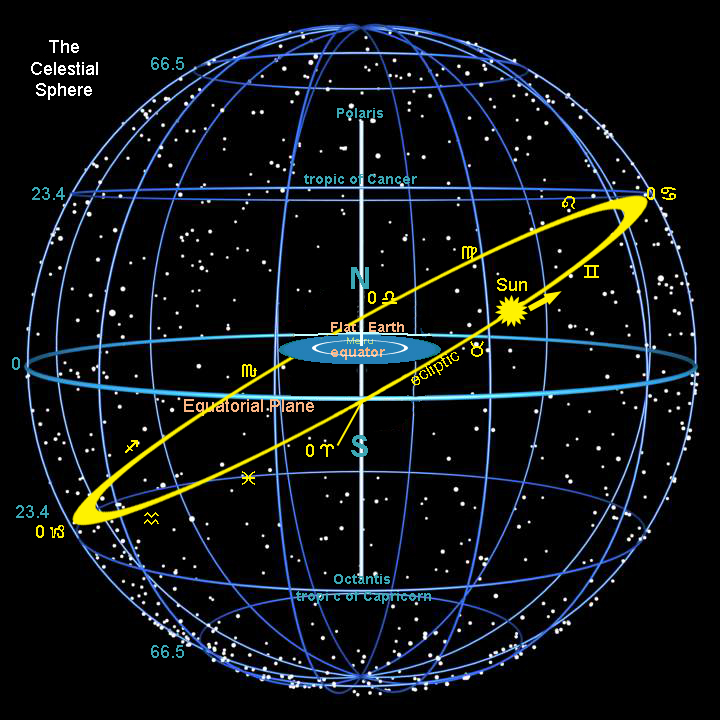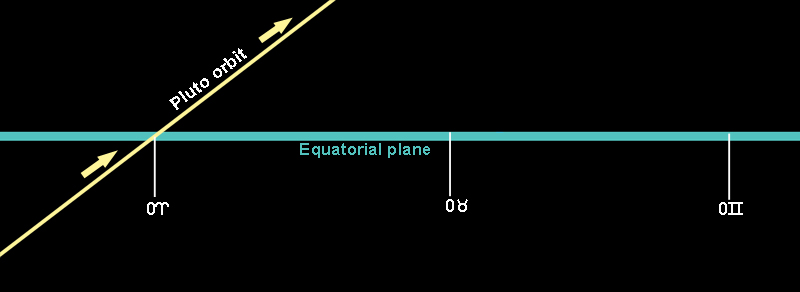|
Note: Much of the information in this article is speculative and may not be entirely accurate Our western tropical zodiac is based on the ecliptic or Sun's path in relation to the Earth's equator. Where the Sun's northward path intersects the Earth's equatorial plane marks zero Aries or the spring equinox. The opposite downward intersection marks zero Libra or the autumnal equinox. Thirty degree segments are then added from both points to obtain our twelve-sign zodiac. This zodiac becomes the reference plane for all the other planets which travel roughly in the same plane or latitude as the Sun. The Moon, Mercury, and Pluto, however, veer sharply from the ecliptic; the Moon by as much as 5 degrees, Mercury 7 degrees, and Pluto 17 degrees. Uranus is closest to the Sun's latitude at less than 1 degree. If we discount Mercury whose closeness to the Sun makes the latitute difference negligible visually, we are left with Moon and Pluto (and most transneptunians). Astrology is based on how the planets or heavenly bodies APPEAR or LOOK from an Earth-based perspective rather than how they might ACTUALLY be(astronomy). It's more of an art than a science. The sky is the canvas and the stars and planets are all painted flatly on its surface. The MOVEMENT or LOCATION of the bodies is what really matters and this is determined from the perspective of your individual time and place of birth. If the Sun's intersection of the earth's equator or plane begins our zodiac what about the Moon's intersection of the Earth's plane? A lot is talked about the Moon's intersection of the solar ecliptic which gives us our lunar nodes, but hardly anything is mentioned about each planet's orbital intersection of the Earth's equatorial plane. Earth's equatorial plane, which is projected outward onto an imaginary but astrologically very real celestial plane, is the reference plane for all other planes. It starts with the Earth and its grid which is our main point of reference against which all other bodies are measured.
There may be several smaller discs or planes (different Earths) above and below us as depicted in Hindu cosmology.  While the Earth is a flat magnet with its own field there is another field emanating from its interior in the shape of a torroidal magnetosphere (not shown here). This stems from the Black or Inner Sun which is the source of our astrolosphere or astrological information. This central Sun inside the Earth may also be the projection source for our Sun, Moon, planets, and stars against the dome/firmament via the polar openings, and directing their courses. The Black Sun is also the root chakra or kundalini force which runs all along the spine from Octantis to Meru to Polaris. The Celestial Sphere is composed of three great circles which allow astronomers to measure any heavenly body via right ascension and declination. These measurements are then converted to longitude and latitude to obtain the astrological equivalents. The first great circle is the Equatorial plane itself which is an extension of the Earth's equator, followed by the Horizon plane which is the individual's observer plane(not seen in the diagram). Then comes the ecliptic plane or path of the Sun. The paths of the other planets closely follow the Sun's path or ecliptic to a few degrees except for the Moon, Mercury, and especially Pluto. The intersections of these three great circles produce important starting points astrologically. Astronomers have proposed something called the invariable plane which would average the plane of most all the other planets but this would compromise the exact plane location of each individual planet leading to errors. Putting all the planets onto the ecliptic and measuring them from there is aready a compromise. Ideally, each body or planet needs its own plane or ecliptic and even zodiac. This is especially so for Pluto, Eris, and most of the Transneptunians which are highly inclined to the solar ecliptic. Pluto's orbit crossing the Earth's equatorial plane, for example, would create its own zero Aries and zero Libra points, establishing it's own separate zodiac. The same is true for any other body so that an infinite amount of zodiacs are possible. We use the solar zodiac or ecliptic almost exclusively because it dominates the sky and most all the other planets follow it. Pluto, Eris, the transneptunians in general, and many asteroids, comets, and centaurs are exceptions to this.
 This can result in a Pluto placement that is different from your regular placement by as much as 15 degrees or more. There can be a five degree difference for the Moon, and one to three degrees for the other planets. The Earth is flat rather than a globe or sphere but the magnetosphere around it is torridal or doughnut-shaped as are all fields including the one around our bodies which esoterists call the aura and both interrelate. This field does not go beyond 66.6 degrees north or south or what we call the arctic and antarctic circles, after which it begins to slope downwards towards the Black or Inner Sun. This Sun is the hidden source of our magnetic field and may be linked astrologically to the Midheaven, as the center of the Earth is also the center of the sky. It may also be the projection source via the polar openings of all the heavenly bodies, as Olaf Jansen discovered. In summary, every orbit of any body crossing earth's equator plane creates its own zodiac, so that there is a Sun zodiac, a Mars zodiac, a Jupiter zodiac, a Chiron zodiac, a Sirius zodiac, etc. Mercury and Venus are Sun-bound so they may be especially subject to the solar plane or ecliptic zodiac, but Mars to Neptune are pretty much independent, at least in the apparent sense. Still, they are very close to the eclipic and therefore can be measured from there. Most of the Plutinos or transneptunians as well as the asteroids, centaurs, comets, and stars stray drastically from the solar ecliptic and may therefore need to be measured differently. back to home |